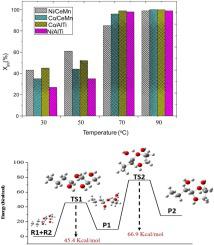Molecular Catalysis ( IF 4.6 ) Pub Date : 2020-09-12 , DOI: 10.1016/j.mcat.2020.111186 Lais F. Oton , Alcineia C. Oliveira , Samuel Tehuacanero-Cuapa , Gilberto D. Saraiva , Francisco F. de Sousa , Adriana Campos , Gian Duarte , João R. Bezerra

|
A series of NiO and Co3O4 supported oxide catalysts was synthesized and investigated in the acetalization of glycerol with butyraldehyde to biofuels production. The catalysts were characterized by XRD, N2 sorption, FTIR and Raman spectroscopy, SEM-EDS and HRTEM techniques. The influence of the catalysts mass, glycerol to butyraldehyde molar ratios, reaction temperature and presence of solvent were deeply investigated. The dispersion of Ni and Co oxides gave distinct effects on the catalytic performances of the solids with AlTi and CeMn being actives in all conditions tested. The mechanistic aspect of the reaction was investigated by density functional theory (DFT). Among the catalysts, the high acidity of the Co/CeMn and Ni/CeMn promoted the acetalization of glycerol more efficiently to produce 4-methanol-2-propyl-1,3-dioxolane, in spite of the glycerol oligomers formation. The correlation of the structure, acidity, morphology and texture of the solids with the catalytic performance was illustrated for solventless acetalization of glycerol with butyraldehyde reaction. The theoretical calculations by DFT studies revealed a more favorable route to 1,3-dioxolane production.
中文翻译:

NiO和Co 3 O 4负载氧化物催化剂上甘油催化缩醛化为生物燃料添加剂的实验结果和理论计算
合成了一系列NiO和Co 3 O 4负载的氧化物催化剂,并研究了甘油与丁醛的缩醛化生产生物燃料的过程。催化剂用XRD,N 2表征。吸附,FTIR和拉曼光谱,SEM-EDS和HRTEM技术。深入研究了催化剂质量,甘油对丁醛摩尔比,反应温度和溶剂存在的影响。Ni和Co氧化物的分散性对固体的催化性能产生了明显的影响,其中AlTi和CeMn在所有测试条件下均具有活性。通过密度泛函理论(DFT)研究了反应的机理。在催化剂中,尽管形成了甘油低聚物,但是Co / CeMn和Ni / CeMn的高酸度促进甘油的乙缩醛化更有效地产生4-甲醇-2-丙基-1,3-二氧戊环。结构,酸度,通过丁醛反应对甘油进行无溶剂缩醛化反应,说明了具有催化性能的固体的形态和结构。DFT研究的理论计算表明,生产1,3-二氧戊环的途径更为有利。


























 京公网安备 11010802027423号
京公网安备 11010802027423号